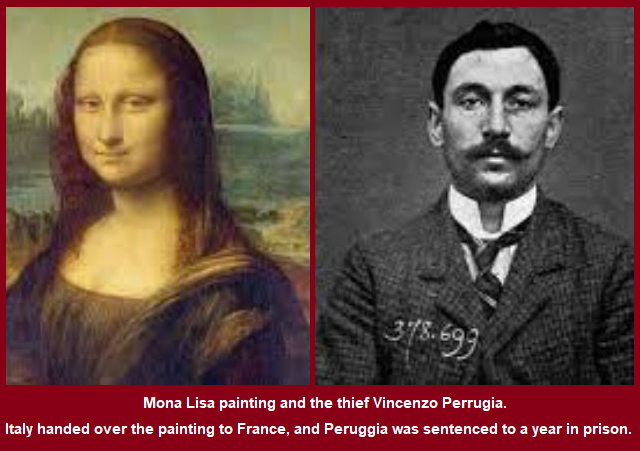Op 21 augustus 1911 werd de Mona Lisa, een van de beroemdste schilderijen ter wereld, gestolen uit het Louvre in Parijs. De diefstal werd een dag later ontdekt door de schilder Louis Béroud. Toen die naar de Salon Carré liep waar het schilderij al vijf jaar te bewonderen was, vond hij een lege plek op de muur. De schilder alarmeerde hierop het museumpersoneel. Aanvankelijk dacht men dat het schilderij was weggehaald om het ergens te fotograferen, maar al snel bleek het kunstwerk van Leonardo da Vinci te zijn gestolen.
Twee jaar later werd het schilderij teruggevonden. Het bleek te zijn gestolen door Vincenzo Peruggia, een Italiaanse patriot en medewerker van het Louvre. De Italiaan had zich in augustus 1911 verstopt in een kast en was later met het schilderij onder zijn jas het Franse museum uitgelopen. Als patriot vond Peruggia dat het werk van Da Vinci te zien moest zijn in een Italiaans museum. Andere lezingen melden dat de Italiaan het doek simpelweg stal om er rijker van te worden. Peruggia liep tegen de lamp doordat hij het beroemde kunstwerk in 1913 probeerde te verkopen aan het Uffizi, een beroemd kunstmuseum in Florence.
Maar, dit verhaal vond ik véél interessanter!
Het komt uit de film 'Art Of The Steal'... Uiteindelijk kwam het er op neer dat de originele Mona Lisa waardeloos was...
The Mastermind
In January 1914, months before Perugia’s trial began, a veteran American newspaperman named Karl Decker was on assignment in Casablanca. While having a drink with an elegant confidence man who went by the name Eduardo, he overheard an interesting story that would shed new light on the disappearance of the Mona Lisa. Eduardo had many aliases, but to his associates he was known as the Marqués de Valfierno or the “Marquis of the Vale of Hell.” With a white mustache and wavy white hair, he looked the part. He had, wrote Decker, “a distinction that would have taken him past any royal-palace gate in Europe.”
Decker had crossed paths with Valfierno in a number of exotic places, and the two had developed a friendship. After the police arrested Vincenzo Perugia, Valfierno commented casually to Decker that Perugia was “that simp who helped us get the Mona Lisa.” When Decker pressed him for details, Valfierno offered to confide his version of the events as long as the journalist promised not to publish them until he gave permission, or died. It was the latter event that allowed Decker to reveal what he had been told, nearly 20 years later, in 1932, in The Saturday Evening Post.
After years of success selling fake artworks, Valfierno moved his operation from Buenos Aires to Paris, where, he said, “thousands of Corots, Millets, even Titians and Murillos, were being sold in the city every year, all of them fakes.” He added people to his organization, including a well-connected American whom he refused to name. Valfierno was selective in choosing those he wished to fleece, concentrating on wealthy Americans who could pay highly for “masterpieces” that had supposedly been stolen from the Louvre.
But Valfierno and his gang never took anything from the Louvre. “We didn’t have to,” he said. “We sold our cleverly executed copies, and … sent [the buyers] forged documents [that] told of the mysterious disappearance from the Louvre of some gem of painting or world-envied objet d’art.… The documents always stated that in order to avoid scandal a copy had been temporarily substituted by the museum authorities.”
Eventually, Valfierno peddled the ultimate prize: the Mona Lisa itself, in June 1910. Not the genuine painting, but a forged copy, along with forged official papers that convinced the buyer (an American millionaire) that, in order to cover the theft, Louvre officials had hung a replica in the Salon Carré. The buyer, unfortunately, had been a little too free in bragging about his new acquisition, which prompted the newspaper Le Cri de Paris to publish an article - a year before the actual theft - stating that the Mona Lisa had been stolen.
Still, it had been a disturbing experience, one that Valfierno was determined to avoid a second time: “The next trip, we decided, there must be no chance for recriminations. We would steal - actually steal - the Louvre Mona Lisa and assure the buyer beyond any possibility of misunderstanding that the picture delivered to him was the true, the authentic original.”
Valfierno never intended to sell the real painting. “The original would be as awkward as a hot stove,” he told Decker. The plan would be to create a copy and ship it overseas before stealing the original. “The customs would pass it without a thought, copies being commonplace and the original still being in the Louvre.” After the Mona Lisa had been stolen, the imitation could be taken out and sold to a buyer who was convinced he was getting the missing masterpiece.
“We began our selling campaign,” recalled Valfierno, “and the first deal went through so easily that the thought ‘Why stop with one?’ naturally arose. There was no limit in theory to the fish we might hook.” Valfierno stopped with six American millionaires. “Six were as many as we could both land and keep hot,” he told Decker. The forger then carefully produced the six copies, which were sent to America and kept waiting for the proper time to be delivered. Valfierno said that an antique bed, made of Italian walnut, “seasoned by time to the identical quality of that on which the Mona Lisa was painted” provided the panels that the forger painted on.
Now came what Valfierno thought was the easy part: “Stealing the Mona Lisa was as simple as boiling an egg in a kitchenette,” he told Decker. “Our success depended upon one thing - the fact that a workman in a white blouse in the Louvre is as free from suspicion as an unlaid egg.” Recruiting someone - Perugia - who actually had worked in the Louvre was helpful because he knew the secret rooms and staircases that employees used.
Perugia did not act alone, Valfierno said. He had two accomplices who were needed to lift the painting, with its heavy protective container and frame, from the wall and carry it to a place where the frame could be removed. Valfierno did not name them either.
The one hitch in the plan was that Perugia had failed to test the duplicate key Valfierno ordered to be made for the door at the bottom of the staircase. At the moment he needed it, the key failed to turn the lock. While he was removing the doorknob, the trio heard footsteps from above, and Perugia’s two accomplices hid themselves. The plumber appeared but, seeing only one man in a white smock, had no reason to be suspicious. He opened the door and went on his way, soon followed by Perugia and the other two thieves. At the vestibule, the guard stationed there had temporarily abandoned his post.
An automobile waited for the thieves and took them to Valfierno’s headquarters, where the gang celebrated “the most magnificent single theft in the history of the world.” Now the six copies that had been sent to the United States could be delivered to the purchasers. Because each of the six collectors thought he was receiving stolen merchandise, he could not publicize his acquisition - or even complain should he suspect it wasn’t the genuine article.
Perugia was paid well for his part in the scheme. However, he squandered the money on the Riviera, and then, knowing where Valfierno had hidden the real Mona Lisa, stole it a second time. “The poor fool had some nutty notion of selling it,” Valfierno told Decker. “He had never realized that selling it, in the first place, was the real achievement, requiring an organization and a finesse that was a million miles beyond his capabilities.”
What about the copies?... Decker wanted to know. Someday, speculated Valfierno, all of them would reappear. “Without those, there are already thirty Mona Lisas in the world,” he said. “Every now and then a new one pops up. I merely added to the gross total.”
Characteristically, perhaps, reports of the date of Perugia’s death vary. It is known, however, that he died in France - an odd end point for a man who had once so vehemently asserted his Italian patriotism. Whatever secrets he knew about the theft were carried to the grave. The Decker account is the sole source for the existence of Valfierno and this version of the theft of the Mona Lisa. There is no external confirmation for it, yet it has frequently been assumed to be true by authors writing about the case. If indeed it is true, Valfierno had carried out the perfect crime.


"Vind mensen, die in zichzelf zowel de motivatie als de aangeboren drijfveer hebben om aan hun Innerlijke Zelf te werken, en we zullen hen gidsen."
- DIMschool vzw, de énige gespecialiseerd in Zelfkennis, zijnde: het kennen van het Zelf -
--------------------------------------------------------------------------------------------------------------------------------------------------
Voel je je geroepen om Spiritualia te sponsoren?
Klik hier en, alvast bedankt!
Overschrijven kan ook via: IBAN: BE22 7795 9845 2547 - BIC: GKCCBEBB
- Ook kan je in onze webshop iets aankopen, waaronder:
Archetypen vragenlijst
Kristallen schedels
Pendels
Purperen plaatjes
Wierook & Benodigdheden
Voor de 'Zoekers naar hun Innerlijke Waarheid' is er...: Eclecticus!
En, dan heb je nog de vaste teksten...
DIMschool biedt 10 interessante privé-sessies aan waaruit jij kan kiezen!
Dossier Zelfkennis: Over de Handleiding Pendelen van A tot Z
'Eclecticus': een korte introductie…
Meteorieten zijn hoogstwaarschijnlijk zo oud als onze planeet: eentje kopen?
Prachtige geode amethist schedel van 4 kg 340 gram zoekt een warme thuis.
Wat is jouw Archetype ? En, ken je ook die van jouw partner?